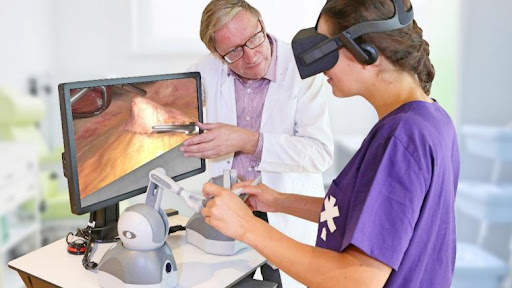Surgery is an art that demands a commitment to lifelong learning. Technology is transforming the surgical environment so fast that it is now almost unthinkable for surgeons to continue to carry out procedures learned in residency for their entire careers without change.
But where can surgeons, from trainees to seasoned professionals, glean this knowledge and experience? Practice, specialty postgraduate courses, mentors, and knowledge transfer from renowned experts all play their part. But, in a world amid a pandemic and with a changing surgical ecosystem, these are not always viable options.
Haptics: a transformational surgical skills transfer
Training residents to become the next generation of surgeons involves significant challenges. Immersive technologies such as haptics, are an invaluable asset to deal with these difficulties. In the virtual world, haptics adds a physical dimension that makes the surgical procedure seem almost real.
The pandemic has forced many hospitals to postpone or cancel elective surgical procedures, squeezing budgets and putting a dark shadow over their ability to remain financially solvent. A pressurized government also demands lower surgical costs and offers less reimbursement for Medicare and Medicaid as it strains to provide essential healthcare resources to citizens in a system stretched to the limits by COVID-19.
The decreased numbers of elective surgical procedures have also decimated hands-on training over the past twelve months, which could have severe implications in the completion of education, recruitment, retention, and enhancing the skills of qualified surgeons. In addition, patient outcomes and safety are dependent on junior surgeons gaining experience under supervision.
Virtual Reality (VR) visualization enhances anatomy training by allowing students and surgeons to immerse in a virtual world. VR plus haptics goes a step further, allowing users to experience, feel and interact with it.
Virtual Reality surgical training provides repeatable and risk-free steps in a guided, quality-controlled environment. This offers a robust foundation for efficient and accelerated learning and the development of ergonomic and precise surgical skills. The addition of haptics brings another sense to the full experience. I equate it to “adding light to the darkness” to “illuminate the Surgical Education Metaverse.”
A mixed approach to surgical training
Blended learning is now an accepted part of surgical training in some areas. Blended learning can be thought of as a mix of different modalities on one platform or education paradigm. It is a cost-efficient option and relieves students from geographical and temporal constraints. To be effective, it needs to be educationally sound. The modules must be relevant to the curriculum and up-to-date with proven critically appraised evidence.
At the same time, the is also an absolute need for standardized measurement of surgical training performance, which paramount to transparency.
Haptic has resulted in simulators that can help train surgeons to obtain a higher degree of precision, accuracy, and safety. Surgical simulators, the same as human cadavers, live animals and, bench-to models, have been designed to recreate surgical situations for skills development and practice. Techniques can be repeated, and complications managed to reach a required level of expertise. These surgical simulations can help in the development of critical psychomotor, technical, and judgment skills.
These flight-style simulators are expensive. Therefore, and despite the apparent benefits, it is not surprising that 0.5% of the world’s surgeons have access to these training modalities.
However, there has been a rapid evolution of innovative haptics solutions that are affordable, portable, and useful to students at all levels of surgical training and bespoke educational solutions for the healthcare market.
FundamentalVR’s Surgical Haptic Intelligence Engine, for example, is combined with off-the-shelf hardware to create an agnostic platform that can accurately mimic the feeling of operating on various layers of human tissue, from skin and subcutaneous fat all the way to bone. Its incredible accuracy lends itself to specialties as diverse as ophthalmology and orthopedics. Traditionally, teaching methods for life science brands, medical institutions, students, and professionals looking to upgrade skills have revolved around lectures, instructional videos, and symposia. Haptics and VR offers a scalable and affordable way to transfer technical knowledge and muscle memory without traveling and also helps compliance with COVID-19 regulations.
Tactile sensing critical to the surgeon’s art
Surgery is a discipline that requires multi-sensory skills where the surgeon depends, among others, on somatosensory feedback for successful operative outcomes. The field of haptics technology replicates tactile and proprioceptive feedback. It has been proven to dramatically enhance learning through real-life sensation.
This is outlined in a recent study at St George’s Hospital in London using haptic feedback in virtual reality bone drilling. This is a technical skill where soft tissue damage must be minimized in order to obtain the best results possible,
The study evaluated a portable haptics system and a 3D printed drill for training on a synthetic tibia bone. The haptic arm is designed to push back with a fixed force against that being applied by the user. The study results indicated a 50% reduction of soft tissue damage for users trained in VR simulations with haptic feedback.
I think that the time has come to protect and enhance surgical training. We have the technology and expertise to do so. We must ensure the highest quality of care. The goal is to have future generations of surgeons excel and exceed our abilities.
Traditional VR simulations have been proven effective in skills development for surgical trainees. The addition of scalable surgical haptics can take VR education to a new level of fidelity and broaden the value of these simulations to experienced surgeons allowing them to keep up with changes in techniques or new biomedical developments.
Haptics has a vital role to play going forward, giving surgeons the confidence, competence, and expertise to manage the changing demands of the modern operating theatre.
About the author
Dr. Rafael J. Grossmann, MD, FACS, is a full-time practicing surgeon in Maine, specializing in general, trauma, advanced laparoscopic, single incision, and robotic-assisted surgeries. He is also a well-known futurist in medical technology and in 2013, was the first doctor ever to use Google Glass during live surgery. He is a passionate advocate of technology’s transformative potential to improve patient care and a global speaker at events including TEDx, Exponential Medicine, and MedicineX.
References
- Gallagher AG, Ritter EM, Champion H, et al. Virtual reality simulation for the operating room: proficiency-based training as a paradigm shift in surgical skills training. Ann Surg 2005;241:364-72
- Forrester Research
- Using haptic feedback in virtual reality bone drilling to reduce plunge distance – Benjamin MW Sabri





